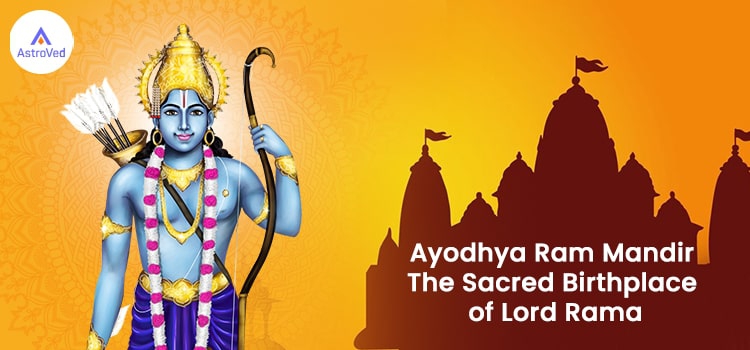Ayodhya Ram Mandir: The Sacred Birthplace of Lord Rama
The ancient and holy city of Ayodhya lies in the heart of Uttar Pradesh. Located along the banks of the Sarayu, a holy river, Ayodhya has a hallowed place in the hearts of Hindus. It is the birthplace of Lord Rama, the 7th incarnation of Lord Vishnu, and the central character in the Ramayana, one of the two greatest Hindu epics. Ayodhya is a place where mythology, history, and spirituality come together. It is not only a renowned pilgrimage site but also an embodiment of India's cultural heritage.

Ayodhya in Mythology
According to mythology, Ayodhya was founded by Manu, a legendary king. However, it is Lord Rama with whom the city is associated today. Born to King Dasharatha and his wife, Kausalya, Rama was the crown prince of Ayodhya. In those days, Ayodhya was the capital of Kosala, an ancient kingdom. As the birthplace of Lord Rama, the city gained eternal fame and sanctity. Hindus regard Rama as Maryadha Purushottam, the ideal man. He is a symbol of righteousness, duty, and devotion and is held up as a role model for everyone.
The Ramayana epic tells the story of Rama's birth, youth, marriage, exile, the abduction of his wife, Sita, the battle against her abductor, the demon king Ravana, and his victorious return to Ayodhya after his 14-year exile. Being the birthplace of Lord Rama, Ayodhya has always been an important pilgrimage for Hindus.
Invoke Rama on his Birthday for Protection, Prosperity and Victory Blessings
Ayodhya in History
Ayodhya’s significance is not just mythological. It has historical importance as well. Once, it was a prosperous center of trade. It boasted a rich culture and a spiritual aura that drew pilgrims from far and wide. Many dynasties rose to prominence in Ayodhya only to vanish in the mists of time, leaving behind their imprints on the city’s landscape. They include the Mauryas, Guptas, and Mughals. Ayodhya’s architecture and culture bear witness to the legacies of these kingdoms.
Ayodhya as a Pilgrimage Spot
Many Hindus hope to go on a pilgrimage to Ayodhya at least once before they leave this world, such is its sanctity and the reverence they hold for it in their hearts. Ram Janmabhoomi, the place where Rama was born, is Ayodhya’s spiritual nucleus. Sacred chants resonate all around, and the fragrance of incense sticks fills the air, creating a divine and mystical aura.
Architectural Heritage of Ayodhya
Ayodhya’s rich heritage is on display in the many temples, shrines, and monuments that dot the city’s landscape. The recently inaugurated Ram Janmabhoomi Temple stands at the site that people believe to be Rama's birthplace. It is the holiest temple in Ayodhya. The architectural heritage of Ayodhya testifies to its glorious past and rich culture. With its majestic spires and exquisite carvings, the temple embodies the hopes, aspirations, and devotion of millions who yearned to honor Rama in the land of his birth. One can see many shrines, ghats, and ancient monuments outside the temple precincts, each with a story of its own.
Notable Landmarks in Ayodhya
Hanuman Garhi
This temple enshrines Lord Hanuman, Rama's devoted companion, and has a towering statue of the monkey god. It offers panoramic views of the city.
Kanak Bhawan
This beautiful temple enshrines Rama and his consort Sita. It has exquisite architecture and idols.
Dashashwamedh Ghat
It is a sacred bathing ghat located on the banks of the Sarayu River. Pilgrims perform rituals and ceremonies here.
Nageshwarnath Temple
It is an ancient Shiva temple. Locals believe that Rama's son, Kush, established it.
Ayodhya Ram Mandir
The Ram Mandir here is made of stone. It has 360 pillars in the Nagara style. The Mandir is 380 feet long, 250 feet wide, and 161 feet tall. It has 392 pillars and 44 doors. The ground floor recreates Rama's life, while the first-floor displays Rama's Darbaar, made using pink sandstone from Rajasthan. For the temple's foundation, holy soil from 2,587 religious sites, like the Golden Temple, Jhansi, and Bithoori, was used. Soil and water from Thailand have also been used.
The Ram Lalla idol installed in the temple's sanctum sanctorum is 51-inch tall. It is made from Shaligram, a special rock estimated to be 60 million years old.
Ayodhya’s Cultural Heritage
Ayodhya celebrates many festivals, like Diwali, Ram Navami, and Kartik Purnima, with great pomp and splendor. These festivals are also occasions to showcase Ayodhya's traditions and rich culture, including its art, music, dance, and cuisine.
Thanks to Ram Mandir, Ayodhya has become a powerful symbol of India's heritage, both spiritual and cultural. It warmly welcomes pilgrims, history buffs, and spiritual seekers with open arms, inviting them to embark on a memorable journey of discovery and faith in the land where Rama took birth to rid the world of evil. In Ayodhya, the past and the present and the mundane and the mystical coexist in harmony. Ram Mandir towers over the landscape like a divine sentinel, calling pilgrims to witness Rama’s presence and glory on earth. Every traveler who sets foot on this holy land discovers the eternal truth that Ayodhya symbolizes - that the path to inner peace and enlightenment is through surrender to God and by upholding Dharma.
Invoke Rama on his Birthday for Protection, Prosperity and Victory Blessings




















